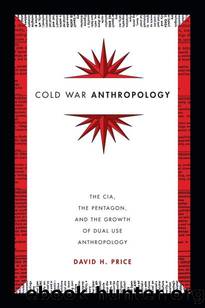Cold War Anthropology by David H. Price

Author:David H. Price [Price, David H.]
Language: eng
Format: epub
ISBN: 9780822374381
Publisher: Duke University Press
Published: 2016-03-09T18:30:00+00:00
Field Agents
During the Cold War, the CIA occasionally used archaeological projects as cover for collecting foreign intelligence. A onetime CIA chief of station, Baghdad, Wilbur Eveland later described the agency using archaeology covers in Iraq during the 1950s, when âpart of the CIA station in Iraq operating under diplomatic cover was so understaffed that even its two secretaries arranged communications drops and safe-house meetings with agents. Wives of the few CIA officers under âdeep coverâ (education and archaeological) typed their reports and sequestered their children while their husbands met with informants at homeâ (1980: 46).
Engineer, philanthropist, and archaeological enthusiast John M. Dimick had no formal training in archaeology, but he was an active presence in major archaeological excavations in Guatemala, Egypt, Turkey, Italy, Greece, and elsewhere from 1946 into the late 1960s. His memoir, Episodes in Archaeology, described how observing excavations at the Herculaneum in 1939 kindled his passion for archaeology. This interest led to fund-raising and managerial roles in archaeological excavations on three continents (Dimick 1968). But there was more going on than Dimick described in his memoir; as his November 29, 1983, Washington Post obituary disclosed, âFollowing service in Spain during World War II, Dimick combined government assignments with archaeological interest while working in Latin America for the U.S. Central Intelligence Agency.â
In 1946, Dimick contacted United Fruit Company founder Sam Zemurray and persuaded him to provide $430,000 for three years of work on Mayan monumental archaeological remains in Guatemala (1968: 26). From 1946 to 1960, Dimick directed the project, hiring Alfred Kidder to undertake the initial surveys. Dimick selected Zaculeu for major restoration efforts, and the crew cleared and excavated the massive temple complex (NBAAA1949 3[3]: 4).
Missing from Dimickâs account of Zemurrayâs Guatemala is any depiction of a Yankee banana republic; instead, we have a description of Zemurray as a kind benefactor looking out for Guatemalansâ interests. Dimick praised his patron, writing that during his âown years in Guatemala the usual derogatory comment on the Fruit Company was invariably sweetened with stories of how it had conquered the Latin Americas by force. That is not only unjustified, but untrue. The conquistador was Zemurray. He with his wisdom, his love for the country as well as for self-benefit, was the power who employed the force of armsâ (1968: 20).
In 1954, two years after Nasserâs Officers Revolution in Egypt, Dimick directed University of Pennsylvania excavations of the Apis embalming house at Mit Rahineh (Dimick 1968: 66). Dimick and his wife, Teena, took an apartment on the top floor of the Semiramis Hotel in Cairo, where they were near âthe living quarters for King Saud of Saudi Arabiaâ (67). Dimick claimed his work with Arab colleagues in Egypt generated mutual aid and assistance, with âno subterfuge, no double talkâ (81). Documents from the Eisenhower administrationâs negotiations with the Nasser administration during Dimickâs time in Egypt include notes from diplomatic meetings of American envoy Robert Anderson (who traveled with several CIA personnel in his party) and establish that Dimick provided briefings on the political climate of Egypt, including his own evaluations of Nasser and his administration.
Download
This site does not store any files on its server. We only index and link to content provided by other sites. Please contact the content providers to delete copyright contents if any and email us, we'll remove relevant links or contents immediately.
| Africa | Americas |
| Arctic & Antarctica | Asia |
| Australia & Oceania | Europe |
| Middle East | Russia |
| United States | World |
| Ancient Civilizations | Military |
| Historical Study & Educational Resources |
Machine Learning at Scale with H2O by Gregory Keys | David Whiting(4183)
Never by Ken Follett(3793)
Fairy Tale by Stephen King(3220)
The Man Who Died Twice by Richard Osman(2997)
Oathbringer (The Stormlight Archive, Book 3) by Brandon Sanderson(2881)
Will by Will Smith(2793)
Rationality by Steven Pinker(2291)
The Dark Hours by Michael Connelly(2243)
Can't Hurt Me: Master Your Mind and Defy the Odds - Clean Edition by David Goggins(2228)
The Dawn of Everything: A New History of Humanity by David Graeber & David Wengrow(2122)
Friends, Lovers, and the Big Terrible Thing by Matthew Perry(2119)
Principles for Dealing With the Changing World Order: Why Nations Succeed and Fail by Ray Dalio(1974)
HBR's 10 Must Reads 2022 by Harvard Business Review(1777)
A Short History of War by Jeremy Black(1762)
Go Tell the Bees That I Am Gone by Diana Gabaldon(1687)
515945210 by Unknown(1599)
A Game of Thrones (The Illustrated Edition) by George R. R. Martin(1589)
Kingdom of Ash by Maas Sarah J(1526)
443319537 by Unknown(1470)
